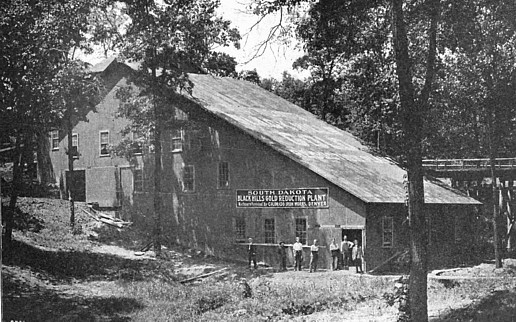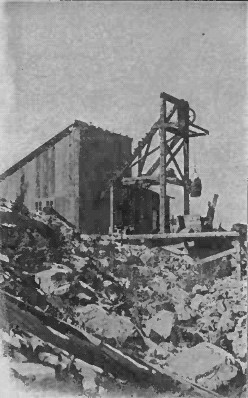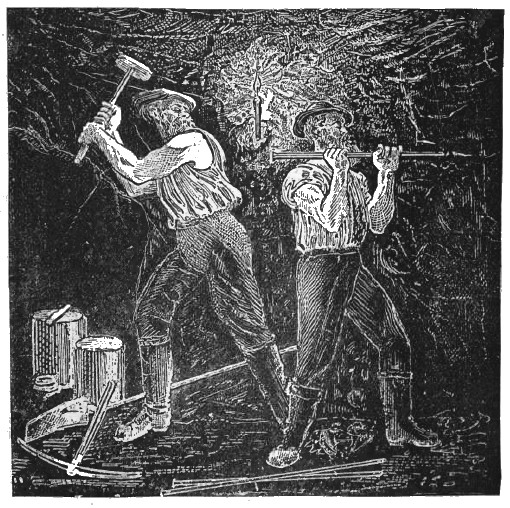I have compared the Homestake deposit to the Rammelsberg, but from the descriptions of von Cotta, von Groddcck and Wimmer many discrepancies exist, not only in that the inclosing rocks of the Homestake are Archaean, while the Rammelsberg deposit is found in the Devonian, but in the shape of the ore-bodies and character of the accompanying minerals. The deposit is also longer and thicker than the Rammelsberg. Beginning with the northern end, it gradually widens until the segregated Old Abe and Homestake are reached, where it has a width of 350 feet by actual measurement. Other ore-bodies are found in the same beds, but occupying different planes. From the shaft upon the Golden Terra extension, the Caledonia discovery shaft lies to the east, a distance of 1,300 feet, measured at right angles to the course of the Homestake. Other ore-bodies also occur, but want of time prevented my giving them any special study. The Caledonia gold ore body is a pyrite and chlorite schist lying between a hanging wall of phyllite and a foot-wall of mica schist, in which there occur layers of chloritic greenstone schist which also carry gold as the main body does. The tunnel intersects before reaching the vein, several small dikes of felsite, whose course is the same as the strike of the ore-deposit. Two ore-bodies are worked by the company, one showing a thickness of about 40 feet and the other a thickness of 180 feet.
If we deal with the " Belt " as a whole, Carpenter regarded it as a particular zone of slates and schists, in which there are many lenses and shoots of ore. These shoots are never solid bodies of pyrite, as in the Rammelsberg, but zones which are impregnated with pyrite. The whole thickness of the beds in which these ore-bodies occur is about 2,000 feet, and they can be traced, I believe, throughout the entire length of the Archaean rocks in the Hills, and are gold-bearing in many other places south of the " Belt." Upon the east and the west sides of it the slates and schists forming the "Belt" pass into quartzite, which maybe regarded as the hanging and foot-walls proper of the deposit. A line drawn upon a given level through the ore channel or shoots constituting the Homestake, Deadwood-Terra and De Smet ore-bodies is absolutely straight, showing that though these shoots vary in size, they all lie in the same plane.
Summary.
The Homestake was originally laid down as a stratified or bedded deposit at
the time the Archaean rocks were laid down. It appears to have been
subsequently modified by infiltration, but these changes also occurred in
Archaean time, for at the formation of the Potsdam, it was fully mineralized
and gold bearing, as I have shown under the head of Placers. It appears to
have been either enriched or the gold concentrated in a more available form
by the porphyry intrusions, which are of Tertiary age. This is shown by the
fact that the yield of gold, both by mill test and
assay, is greater in the
vicinity of these bodies than remote from them. The beds in which the gold
occurs can be traced throughout the Hills, and are gold-bearing in many
places south of the Belt proper.
MINING UPON THE BELT.
Different methods of mining are pursued upon the Belt. The surface ores are
worked by large open cuts, and at a minimum cost, but as the depth which can
be reached by this method, even where the deposit is from 150 to 200 feet
wide, is limited, extensive underground workings exist upon all the mines
except the De Smet. In the Homestake mines the ground, as fast as broken, is
securely timbered by the Nevada "square set " and filled solidly with waste
rock. At the Caledonia no timber is used, the ground being safely supported
by solid pillars and worked in a way which is a little different from that
ordinarily pursued where no timber is used. The cost of mining at the
Highland and Deadwood Terra, judging from the average yield of the ore, must
have been very much less than this. The difference is probably to be
accounted for by their greater amount of open-cut work.
Other Deposits.
Aside from the Homestake, other deposits of this class have been but little
worked. Numerous beds of similar pyritiferous gold bearing schists exist
throughout the Hills, which, so far as surface indications go, cannot be
told from parts of the Homestake belt. In the early days of the settlement
of this section, numerous small
stamp mills were built, but from various causes they failed to pay.
If the Homestake was worked in a small way it, also, would not pay. It is
the enormous scale upon which these mines are worked, thus reducing
everything to a minimum cost, that enables them to run at a profit. This may
seem like a contradiction, but no small mills, even in this section, were
ever able to make a profit. That deposits carrying free gold to nearly or
quite the same extent as some of the Belt mines exist in other parts of the
Hills, is well known. Many samples, not " specimens," were taken during the
progress of this work, which, at the School of Mines, returned by
free-milling tests from $2.00 to $12.00 per ton, this last amount having
been returned from claims in both Custer and Pennington counties. As
free-milling ores can be tested by any miner with a common mortar and pan,
we did not devote the same time to their examination as to those ores which
require more technical knowledge for their treatment. These last deposits,
save in the gossan or outcrop, show little or no free
gold quartz. Beyond this, they do not
differ from the deposits already described, and, like them, carry ores in
immense quantities. If they can be successfully treated, the gold output of
the Hills will be materially increased. I spent much time in their study. If
the gold was in the sulphides, I saw no reason why it might not be
concentrated to a valuable product. If these bodies were solid pyrite, of
course no concentration could be made. If occurring in small veins, the cost
of mining would be too great, for their value seldom reaches $6.00 per ton.
It seemed that a hint might be taken from the large mines of the
Lake Superior copper region, where, owing to the great quantity in
which low grade copper ores occur, as well as to the ease with which they
can be concentrated, enormous dividends have been paid from ores worth far
less, as they are broken from the mine, than those of which I speak. The
Atlantic copper mine of that section made in 1885, 1886 and 1887, the
following extraordinary showing The rock yielded only 0.743 per cent of
refined
copper ore.
Of the vast quantity of these pyrite ores there was no doubt, for the beds seldom showed less than 50 feet in thickness and could be traced for thousands of feet. They could be mined and concentrated probably, as cheap as at the Atlantic. Could rock yielding less than $5.00 in gold, not free-milling, be made to pay? I knew of no such case; but, upon the other hand, there were the copper deposits paying fine dividends upon ore of far less value. I began the study of the question. The results obtained were not always satisfactory, and while we have in the metallurgical laboratory ample machinery, I could not, for reasons stated, treat any of the lots upon a working scale; but I found some deposits which will not only repay a judicious investment of capital, but give employment to many hundreds of men. Not wishing to appear to be advertising anyone's claim, I give only results: No. 1. This claim is one of a large group located in Pennington county. The deposit is more than 100 feet wide, and can be clearly traced for 4,500 feet. The ore appears to be a hornblendic schist, which in places succeeds to a mica schist, and this often to a schistó character not determinedóbut highly plumbaginous. These are impregnated with ordinary pyrite and arsenopyrite. The creek, for some distance below the crossing of the bed, has been extensively worked for placer gold nuggets, which I believe to have been derived from this deposit. Many tests were made from different parts of the ore-bed, with good results. The following is one from the main workings: Average value of rock, $6.19. This was concentrated and yielded 22.15 per cent; concentrates worth per ton $22.73. Amount saved by chlorination, $20.46; that is, 4.51 tons of rock yielded one ton of concentrates, returning $20.46. This should have been, with good concentration, very much greater. I am unable to account for the loss; but, notwithstanding this, the size of the deposit, the facility for working, etc., would yet leave a profit. The Belt probably extends through the county, if not the Hills, and is believed to be a continuation of the zone from which the first Pennington County sample above was taken.
Return
to The South Dakota Page:
South Dakota Gold Rush History




